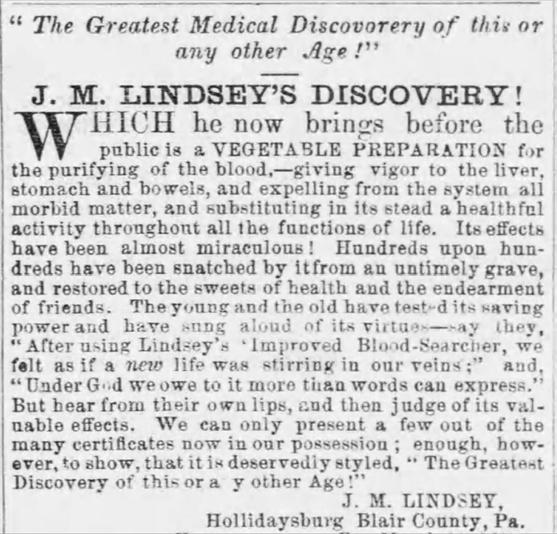
26 minute read
by Zach BaerJ.M. Lindsey and his World Renown Blood Searcher
By: Zack Baer, with significant contributions by Bill Lindsey
How I Caught the Blood Bottle Bug sey’s, I figured I had better find out a bit more about the bottle’s
Having been born and raised in western Pennsylvania, I have soon started scouring the internet for more information. always had a fascination for early druggist bottles from the area. To me, one of the quintessential western PA druggist bottles Eventually, my search led me to Bill Lindsey [creator of the Hishas to be “Lindsey’s Blood Searcher.” It is a large, imposing recttoric Glass Bottle Identification & Information Website (https:// angular bottle with sunken panels, and an applied top. My bottle sha.org/bottle/); as a side note, if you have never visited the webcollecting buddy Jeff Mahalik just so happens to have two Lindsite go check it out it is an invaluable resource!] and his extensive sey’s in his collection. He has a killer dark olive-green taper top Lindsey’s collection. I sent Bill an e-mail and he informed me he variant embossed with the town name of Hollidaysburg, which he has been a longtime Lindsey’s collector (because of the propridug with Rick Ronczka, and Digger O’Dell behind the house of a etors last name) and that he currently owns nine different mold river boat captain (the story of the dig was published in Antique variations of the bottle. I asked him if he knew of any articles or Bottle and Glass Collector, October 2005; “A Rare Find”). The books that provide a more of an in-depth look at the history of other variant Jeff owns is an aqua example with a double collar Lindsey and his medicine and he said that he did not. This got my applied lip with the city of Pittsburgh embossed on it. This is a wheels turning. Using Bill’s knowledge of the Lindsey’s bottle more common variant but still variants, I thought I could pull looks great sitting on his self. together some history and write Since I found myself staring at to help in my endeavor, so off these bottles every time I went to the newspaper archives I over to visit Jeff, I soon realwent… ized I needed to add a Lindsey’s to my own collection. I The History didn’t have the funds required history. I read the short history excerpts in my bottle books and an article. Luckily Bill agreed to purchase an olive-green Not a lot is known about Jesse Hollidaysburg example (even M. Lindsey, the inventor of the if I could find one for sale), so blood searcher which bears his I decided I should settle for an name. He was born in Hollidayaqua one instead. So, the hunt sburg, Pennsylvania in Septembegan. I was lucky enough ber 1822 to James and Rachel to find a nice aqua Pittsburgh Lindsey. He was described as 5 example at the Washington, foot 6 inches tall with a sandy PA bottle show on the table complexion, blue eyes & sandy of fellow club members Bob colored hair. Lindsey married and Edna DeCroo. We talked Hannah Ann Townsend Aultz about the bottle for a while on 18 December 1846, together and eventually they agreed to the couple went on to have nine trade me for it. Finally finding myself the owner of a LindFigure 1. One of the first newspaper advertisements for Lindsey’s Blood Searcher, from The Lancaster Examiner, 7 April 1858. children together. The 1850 census listed Lindsey’s oc

Mold 3 – “LINDSEY’S // BLOOD + / SEARCHER // HOLLIDAYSBURG”, Color: deep olive green
use it freely, and in a short time, to his most delightful astonishment, there was a very perceptible change for the better… Hope was inspired, and the use of the compound was faithfully continued, the result of which, with the blessing of God, was her complete restoration. She is now perfectly healthy! From this circumstance, Mr. Lindsey was led to prepare, with greater care and exactness, what had so astonishingly cured his child, and continued his experimental efforts until he succeeded in bringing to perfection his Great Remedy for Blood Impurity” It seems that Lindsey began to sell his blood searcher in a commercial capacity by late 1856 as his first patient testimonials are dated 1857 (if the blood searcher was sold prior to that date there should be earlier testimonials). By July 1858, Lindsey had made a partnership with R. M. Lemon under the name of Lindsey & Lemon and together they shared the proprietorship of the blood searcher. Business prospered and Lindsey’s Blood Searcher was being sold at multiple drug stores all over Pennsylvania. As was customary at the time, an agent was appointed to assist with the distribution of the medicine. Dr. George H. Keyser was selected as the Pittsburgh wholesale and retail agent by May 1859. At the same time, it seems Lindsey decided to withdraw from the manufacture of the blood searcher. By June 1859, advertisements began to list the sole proprietor as Lemon. There were still a few lingering advertisements listing both Lindsey & Lemon as proprietors until around July 1860, but an October 1860 billhead does
Unfortunately, a fire entirely consumed Lemon’s laboratory near the Pennsylvania Railroad Depot in February 1861. After which it appears Lemon transferred the rights to the blood searcher to his Pittsburgh wholesale agent George Keyser. I could not find any documentation of when this transfer of rights officially took place but I believe it likely occurred soon after the fire. By January 1862 Keyser was advertising his proprietorship of Lindsey’s Blood Searcher from his office at 140 Wood Street, Pittsburgh, PA. Keyser went on to use newspaper advertisement testimonials to proclaim the superiority of Figure 2. Advertising cover for R.M. Lemon’s Lindsey’s Improved Blood Searcher, circa 1860, from the Schuy“his” blood searcher formula: ler Rumsey Philatelic Auction, Sale 82: United States Advertising Covers, Lot 3588. cupation as “Druggist” and it should be noted that Lindsey was likely producing his Lindsey’s Cholera & Diarrhea Medicine and Lindsey’s Cough Balsam around this time. Searcher which was made before Dr. Keyser commenced making it. Although it helped me some, I did not recover fast, until I got the kind made by Dr. Keyser himself. One bottle of his did more good than two of the old. I believe it is According to an early newspaper advertisement, Lindsey first fora great deal stronger and better” mulated his blood searcher in the fall of 1854 when his daughter fell victim of “Cancrum Oris (Canker of the mouth) … her mouth and cheeks were literally rotten… (and) everything (was) indicating a speedy and horrible death.” The advertisement continues on: Lindsey however did not agree with Keyser’s ownership of the blood searcher and began to once again prepare his medicine in Hollidaysburg by early 1862. He enlisted Pittsburgh druggist Simon Johnston as a sole agent by March 1862 and went on to denounce the Keyser’s Lindsey’s Blood Searcher. So, both Lind“Mr. Lindsey prepared a compound for the purpose of alleviating, if possible, the pains of the little sufferer. She was made to sey and Keyser were selling their own Lindsey’s Blood Searcher and calling each other’s medicines counterfeiters.

“I would also state that I took the Blood

Figure 3. One of the many outlandish newspaper testimonials provided to entice prospective clientele to try Lindsey’s Blood Searcher; from the Altoona Tribune, 10 March 1863.
Wanting to once again get away from the manufacturing of medicine, Lindsey pulled the blood searcher rights from Johnston and instead sold them to J.M. Fulton (office being located at Nos. 67 and 69 Fifth Street, Pittsburgh, PA) on 21 November 1863. Fulton firmly placed his claim on the medicine stating in his inaugural newspaper advertisement “upon every bottle the name of J.M. Fulton should appear… every infraction of my trade-mark will be prosecuted to the extent of the law.” Supposedly Fulton even employed Lindsey as a part time superintendent and even claimed that Lindsey himself “will be permanently located at Nos. 67 and 69 Fifth St., where he is now preparing blood searcher.” This was likely a marketing tactic however as there is no proof Lindsey ever moved to Pittsburgh from his Hollidaysburg home.
Figure 4. The beginning of an 1863 newspaper ad in which J.M. Lindsey announces to the world not to buy Keyser’s counterfeit Lindsey’s Blood Searcher; from the Raftsman’s Journal, 25 February 1863.
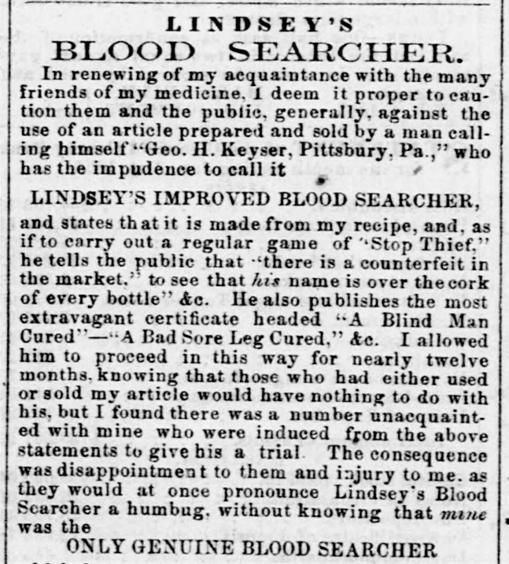
It seems Keyser was not very concerned about Fulton’s threat of prosecution as he continued selling the blood searcher only adding his own name in front of the medicine’s title: “Dr. Keyser’s Lindsey’s Blood Searcher”. His own advertisements went on to state:
“Look out for the name of Dr. Geo. H. Keyser on the cover of the bottle and pasted over the cork; also for his United States stamp on the top of the bottle, to prevent being imposed upon by a spurious article which is in the market.”
An interesting side note: Keyser enlisted Lindsey’s ex-agent Simon Johnston to help him sell his version of the blood searcher. This was the same blood searcher that just years earlier Johnston was advertising against. Clearly Johnston did not appreciate Lindsey pulling his contract with him and selling the medicine rights to Fulton. Johnston even went so far as to place an adver
tisement for “Dr. Keyser’s Lindsey’s Blood Searcher” denounc

Figure 5. A newspaper ad placed by J.M. Fulton outlining his ownership to Lindsey’s Blood Searcher, from The Pittsburgh Gazette, 7 December 1864.
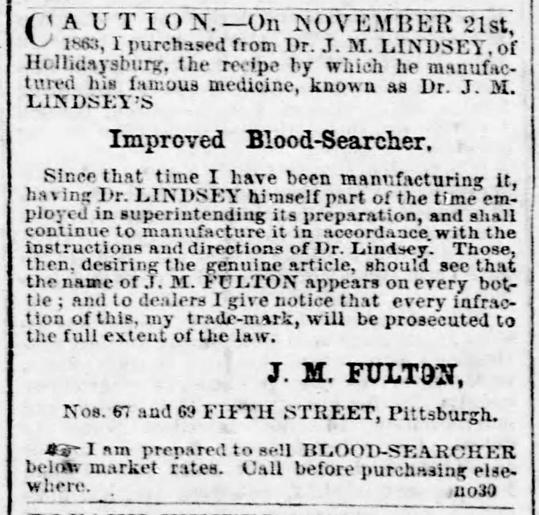
Figure 6. A newspaper ad showing the start of the transition from Dr. Keyser’s Lindsey’s Blood Searcher to Keyser’s Blood Searcher, from the Altoona Tribune, 4 May 1864.
Bottle Mold Variants
Bill has documented 10 individual Lindsey’s Blood Searcher bottle mold variants and there are at least two different Keyser’s Blood Searcher bottle mold variants. At first glance some of these variants can be difficult to distinguish since the embossing found on these bottles barely changed over the nearly 75 years of production. Notes on how to distinguish each mold are provided with each mold listed. It is possible, and even likely, that the variant list below is incomplete. Hopefully, as more people take note of their particular bottle’s mold this list can be added to. Lindsey Variants

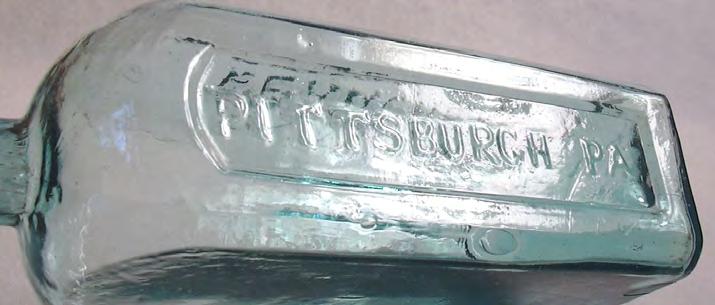
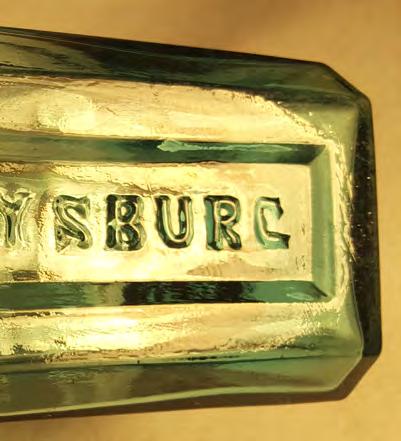
Mold 2 – “LINDSEY’S // BLOOD + / SEARCHER // PITTSBURGH PA.”, Color: aqua; Dimensions: 8 3/4”h, 3 11/16”w, 2 3/8”d; Base: hinge mold or red iron pontil (possibly unique); Finish: applied double ring; Embossing notes: This is the only Lindsey variant embossed with the state abbreviation after the city name. Notes: This is the only Pittsburgh variant that is found with an iron pontil. This bottle is very similar to the Dr. Keyser’s Blood Searcher Mold 1 – “LINDSEY’S // BLOOD + / SEARCHER // HOLLIDAYSBURG”, Color: aqua; Dimensions: 9”h, 3 15/16”w, 2 11/16”d; Base: hinge mold bottle (description below) in appearance, and both bottles have the state abbreviation. It is possible that this is the first bottle used by Keyser after purchasing the medicine’s rights from Lemon. Estimated production date: 1862-1866. (relatively abundant) or red iron pontil (very rare); Finish: applied double ring; Embossing notes: serif font, the “G” at the end of Hollidaysburg looks like a sloppy “C”. Notes: This is the only Hollidaysburg variant that is found with an iron pontil. Estimated production date: 1856-1864.
Mold 3 – “LINDSEY’S // BLOOD + / SEARCHER // HOLLIDAYSBURG”, Color: deep olive green; Dimensions: 9 3/16”h, 3 15/16”w, 2 3/4”d; Base: hinge mold; Finish: applied one part oil finish (taper top); Embossing notes: The “G” in Hollidaysburg is of a gothic font distinctly different from Molds 1 & 4. Notes: While not found with a pontil base, these bottles are very crude and have been dug in privies along with early pontil bottles. Estimated production date: 1856-1864.
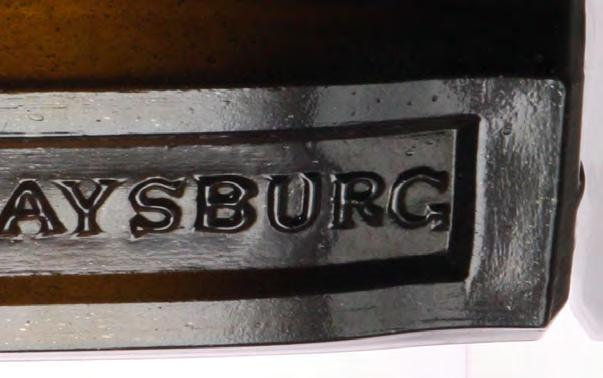
Mold 4 – “LINDSEY’S // BLOOD + / SEARCHER // HOLLIDAYSBURG”, Color: aqua; Dimensions: 9 1/8”h, 3 15/16”w, 2 11/16”d; Base: hinge mold; Finish: applied one part oil finish (taper top); Embossing notes: Serif font, The “G” in Hollidaysburg is a typical “G” not like those found on Mold 1 or 3. Notes: This bottle looks similar to Mold 3 but has steeper sloping shoulders. This bottle has been dug in privies along with early pontil bottles. Estimated production date: 1856-1864.

Mold 5 – “LINDSEY’S // BLOOD + / SEARCHER // PITTSBURGH.”, Color: aqua; Dimensions: 9 1/8”h, 3 13/16”w, 2 3/4”d; Base: hinge mold; Finish: applied double ring; Embossing notes: The only variant that has a period after the “H” in Pittsburgh. The “S” in Pittsburgh resembles a “9”, likely resulting from the mold engraver forgetting to reverse the “S” and then trying to fix the mistake. Estimated production date: 1862-1866.


Mold 7 – “LINDSEY’S // BLOOD + / SEARCHER // PITTSBURGH”, Color: aqua; Dimensions: 8 3/4”h, 3 3/4”w, 2 1/2”d; Base: post mold; Finish: applied double ring; Embossing notes: There is a significant amount of peening or mold repair beneath the “Lindsey’s” and “Pittsburgh” embossing on bottle’s side panels. Estimated production date: late 1860s/ early 1870s - mid/late 1870s.

Mold 8 – “PITTSBURGH // LINDSEY’S / BLOOD / SEARCHER // R.E. SELLERS & CO PROP’S”, Color: aqua; Dimensions: 8 7/8”h, 3 5/8”w, 2 1/4”d; Base: post mold; Finish: applied double ring; Embossing notes: serif “S”, “L”, “B” and some of the “E”s. This is the only R.E. Sellers & Co variant that does not have a period “Co”. Estimated production date: mid/late 1870s - mid 1880s.
Mold 6 – “LINDSEY’S // BLOOD + / SEARCHER // PITTSBURGH”, Color: aqua; Dimensions: 8 1/4”h, 3 3/4”w, 2 1/2”d; Base: hinge mold; Finish: applied double ring; Notes: This is the shortest of all of the Lindsey bottles and is also one of the most abundant variants. Estimated production date: 1862-1866. Mold 6 is on the right

Mold 9 – “PITTSBURGH // LINDSEY’S / BLOOD / SEARCHER // R.E. SELLERS & CO. PROP’S”, Color: aqua; Dimensions: 8 13/16”h, 3 11/16”w, 2 1/4”d; Base: cup base mold; Finish: tooled sharp angled double ring; Embossing notes: sans serif embossing except the “T” and “E”s. Estimated production date: mid/late 1880s - early 1890s.
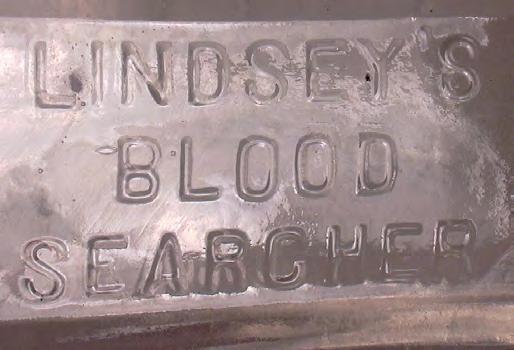
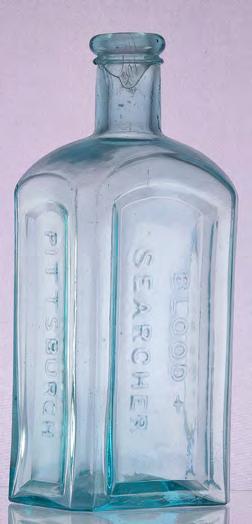
Mold 3 – “LINDSEY’S // BLOOD + / SEARCHER // HOLLIDAYSBURG”, Color: deep olive green; Dimensions: 9 3/16”h, 3 15/16”w, 2 3/4”d; Base: hinge mold; Finish: applied one part oil finish (taper top); Embossing notes: The “G” in Hollidaysburg is of a gothic font distinctly different from Molds 1 & 4. Notes: While not found with a pontil base, these bottles are very crude and have been dug in privies along with early pontil bottles. Estimated production date: 1856-1864. Mold 10 – “PITTSBURGH // LINDSEY’S / BLOOD / SEARCHER // R.E. SELLERS & CO. PROP’S”, Color: clear (relatively common), pink amethyst (rare); Dimensions: 8 13/16”h, 3 5/8”w, 2 3/16”d; Base: cup base mold; Finish: tooled sharp angled double ring, some are found with the bottom ring almost non-existent; Embossing notes: sans serif embossing. Notes: This variant still has R.E. Sellers & Co. embossed on the bottle, however, there are labeled examples with the writing “McCullough Drug Co., Sole Distributors / Lawrenceburg, Indiana / Successors to W.J. Gilmore Drug Co., Pittsburg, Pa.”. Since McCullough did not own the rights to the blood searcher until 1917, it is likely this mold was originally cut for Sellers and was continually used by Gilmore and then McCullough. Why they would not remove the past proprietors name from the bottle is unknown. Estimated production date: late 1890s -late 1910s.

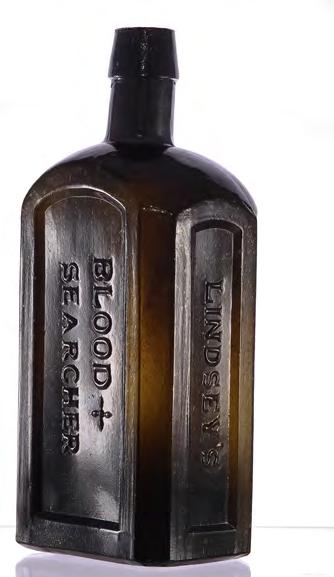
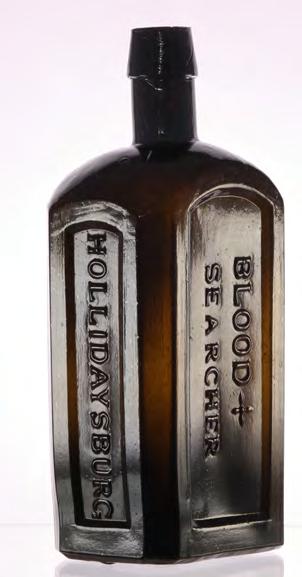


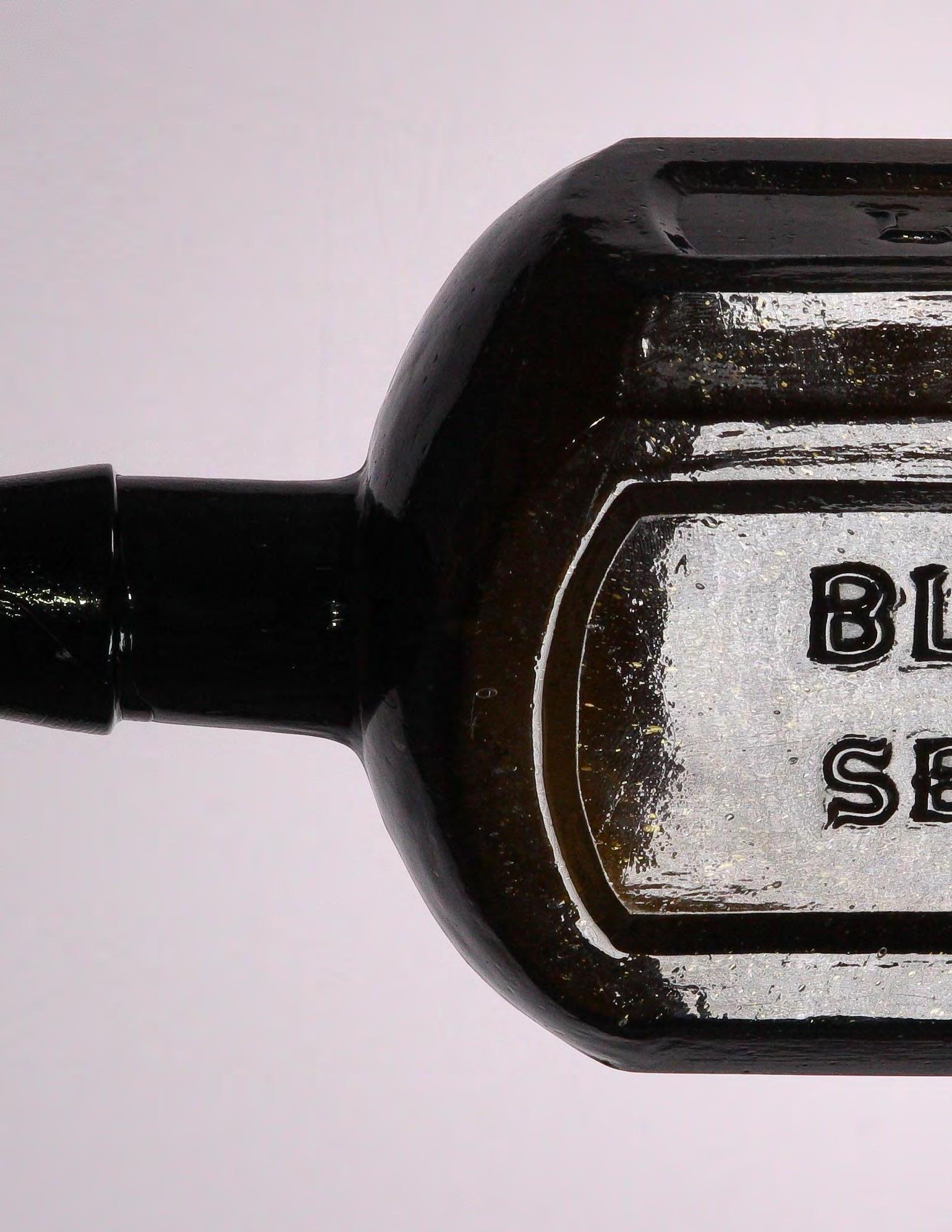
Mold 7 – “LINDSEY’S // BLOOD + / SEARCHER // PITTSBURGH”, Color: aqua; Dimensions: 8 3/4”h, 3 3/4”w, 2 1/2”d; Base: post mold; Finish: applied double ring; Embossing notes: There is a significant amount of peening or mold repair beneath the “Lindsey’s” and “Pittsburgh” embossing on bottle’s side panels. Estimated production date: late 1860s/ early 1870s - mid/late 1870s.
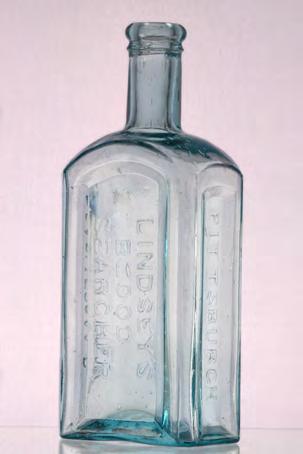


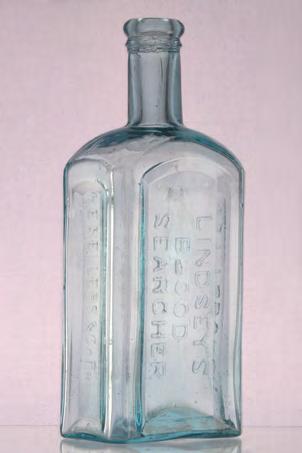
Mold 8 – “PITTSBURGH // LINDSEY’S / BLOOD / SEARCHER // R.E. SELLERS & CO PROP’S”, Color: aqua; Dimensions: 8 7/8”h, 3 5/8”w, 2 1/4”d; Base: post mold; Finish: applied double ring; Embossing notes: serif “S”, “L”, “B” and some of the “E”s. This is the only R.E. Sellers & Co variant that does not have a period “Co”. Estimated production date: mid/late 1870s - mid 1880s.



Mold 1 – “DRKEYSER’S // BLOOD + / SEARCHER // PITTSBURGH PA”, Color: aqua, green (rare); Dimensions: 9 1/4”h, 3 5/8”w, 2 3/16”d; Base: hinge mold; Finish: applied double ring; Embossing notes: serif “S” in searcher. When looking at the front panel horizontally the “B” in blood starts directly above the end of the letter “S” in searcher below; Estimated production date: 1866 - mid 1870s.
Mold 2 – “DRKEYSER’S // BLOOD + / SEARCHER // PITTSBURGH PA”, Color: aqua; Dimensions: Unknown (likely similar to the Keyser mold 1); Base: Unknown (likely hinge mold); Finish: Applied double ring; Embossing notes: sans serif embossing. When looking at the front panel horizontally the “B” in blood is directly in line with the “E” in searcher below it; Notes: A single photo of this variant was found online but little information was provided. Estimated production date: 1866 - mid 1870s.

ing Fulton’s claim of ownership and claiming that he held Lindsey’s “exclusive appointment” to sell the medicine. Lindsey’s sale of rights to Fulton did however come with a caveat; the rights for the blood searcher were only valid for the period of one year, meaning that Fulton’s rights to the blood searcher expired in November 1864. It seems Fulton either blatantly ignored this, or was unaware of the stipulation, as he continued to produce the medicine well past this date believing he was the rightful owner. Lindsey on the other hand was well aware of the expiration and had even found a new buyer. On 7 October 1864, Lindsey sold his “perpetual and exclusive” rights to his blood searcher to R.E. Sellers & Co. for the sum of $500. This exclusive sale meant that Lindsey would never again own the rights to his blood searcher. It is possible Lindsey made this permanent sale, instead of a temporary one, because he was planning on leaving to fight in the Civil War. He enlisted in March 1865 as a private in the Co. H Regiment 103 of the Pennsylvania infantry. Fulton and Sellers began heavily competing with one another for a stake in the blood searcher game and soon Sellers began to pull ahead. This did not sit well with Fulton. In 1865, he filed a $10,000 lawsuit alleging the loss of business caused by Sellers’ publications and statements denying Fulton the right to manufacture Lindsey’s Blood Searcher. However, Fulton’s tactic misfired, and the case was dismissed as a non-suit. Sellers struck back in May 1866 by filing an injunction against Fulton to stop him once and for all from producing the blood searcher. With the signed bill of sale from Lindsey in hand, Sellers prevailed and the court ordered Fulton to stop the sale of the blood searcher in July 1867. Fulton appealed but was unsuccessful and was ordered to stop all manufacturing and sales of the medicine in November 1867. It seems this court battle did not go unnoticed by Keyser or perhaps Sellers then went after Keyser as well. Whatever the case, by July 1866 Keyser dropped “Lindsey’s” from his medicine’s name and continued to sell it as Dr. Keyser’s Blood Searcher. Keyser moved his drug store to 167 Liberty Street in January 1869 in order to expand his drug business selling his blood searcher and his now popular Keyser’s Pectoral Syrup, and Keyser’s Lung Cure. Interestingly, around the same time Keyser began to distance himself from the drug business. He instead devoted himself to the practice of medicine (particularly focusing on the lungs). I was unable to find any advertisements for
Figure 7. An early R.E. Sellers & Co. newspaper ad which includes a transfer of rights testimony written by J.M. Lindsey; from The Summit County Beacon, 16 March 1865.
Keyser’s Blood Searcher after 1871 but there are advertisements

Figure 9. A newspaper ad in which Fulton made it clear that they were not going to stop producing Lindsey’s Blood Searcher without a fight, from The Pittsburgh Daily Commercial, 6 August 1867.


Figure 11. An ad proclaiming Lindsey’s return to the world of patent medicine with his Lindsey’s World-Renowned Panacea, from the book: History of the City of Altoona and Blair County. Including Sketches of the Shops of the Pennsylvania Railroad Co. 1880.

for his other medicines up until 1889. It seems possible Keyser rebranded the blood searcher as his lung cure. This assumption is based off of an 1873 advertisement that heralds the dangers of “impure and faulty” blood and promotes Keyser’s Lung Cure’s ability to “restore the blood”.
Meanwhile, Lindsey had survived the war after being discharged in June 1865 due to injury. He eventually settled in Altoona, PA and by 1880 was once again producing a line of patent medicines, this time under the partnership of Lindsey & Beckman at 11th Avenue. Conveniently, Lindsey had a “new and wonderful remedy for the blood” which he went on to name: Lindsey’s World-Renowned Panacea. This seems like a blatant attempt to ride his earlier medicine’s success after possibly regretting selling his rights to it. Later advertisements would go a step farther and call the medicine “the only genuine blood purifier”.
Lindsey, however, did not receive the world-renowned fame he once had. By 1886, newspapers were referring to Lindsey as “a medical practitioner of doubtful reputation” and local boys made it a habit to call him “quack” when they saw him on the streets. The boys apparently harassed Lindsey so much so that newspapers report an instance where he “armed himself with an immense horse pistol 14 inches in length and then sallied forth with a determination to perforate the first urchin who should make game of him”. He shot into the crowd of hecklers and injured two innocent bystanders. No doubt this did little to improve his reputation. Lindsey’s name was further tarnished in June 1888 when he was arrested for attempting to conduct an abortion. This was a criminal offense at the time and the court took no pity on him. He was sentenced to two years in the western penitentiary and subsequently died in October 1890 (possibly while still in jail). The last advertisement I could find for Lindsey’s World-Renowned Panacea was placed in April 1891.
Figure 12. An original Lindsey’s World-Renowned Panacea advertising sign circa 1880 from the collection of Bill Lindsey.
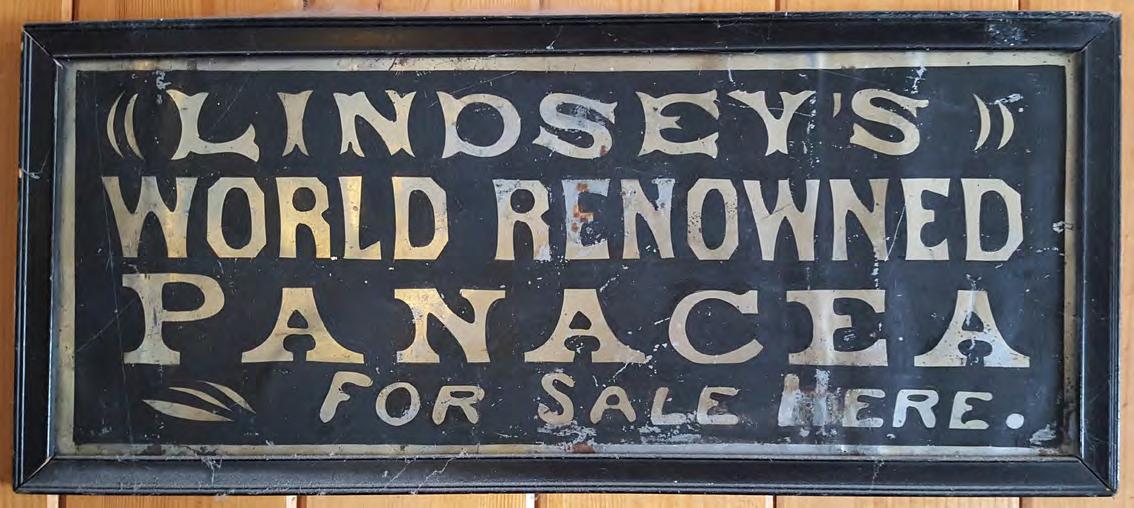
They began heavily advertising Lindsey’s Blood Searcher in the mid-1870s and it quickly became one of Sellers most popular medicines. Sellers continued to advertise Lindsey’s Blood Searcher until May 1893, but by April 1898, Sellers had sold the rights to the medicine to the W.J. Gilmore Drug Company of Pittsburgh. Gilmore must have had some success selling the medicine as it went on to protect its investment by filing a trade mark for a stylized logo for the medicine on 11 November 1913. The trade mark was granted 10 March 1914.
Even so, this time period was hard on the patent medicines of old as the world was realizing these preparations provided little to no medical benefit to the user. In June of 1906, the Food and Drugs Act was passed as the first Federal effort to regulate adulterated and misbranded food and drugs. The Act directed the U.S. Bureau of Chemistry to inspect products in question and refer offenders to prosecutors. In February 1916, the Bureau confiscated a shipment of Lindsey’s Blood Searcher for testing. Analyses showed that the medicine “consisted essentially of extracts of plant drugs, salicylic acid (0.1%), alcohol (10%), and water.” At the time, Gilmore was advertising the blood searcher as a harmless vegetable compound, however, the Bureau determined the medicine contained non-vegetable ingredients that could be potentially harmful. It was determined that Gilmore had misrepresented its medicine and a $50.00 fine was leveled against the company in June of 1918. However, before the Bureau’s ruling, Gilmore must have realized its blood searcher was being investigated and that it was in danger of losing its medicines credibility. In an effort to squeeze the last bit of revenue out of the soon to be denounced medicine, Gilmore sold the rights to Lindsey’s Blood Searcher to the McCullough Drug Company of Lawrenceburg, Indiana in February 1917 for $1,500.00.
McCullough held the rights to Lindsey’s Blood Searcher for the remainder of the medicine’s life. It seems the blood searcher was still being advertised, all be it very infrequently, as late as 1925 but its days of being a well-respected remedy were over. The
Figure 13. The first W.J. Gilmore Co. Lindsey’s Improved Blood Searcher ad; from the Butler Citizen, 14 April 1898.

blood searcher had come to be known as a nostrum. A newspaper article mentioning the blood searcher put it like this: “The medicine at one time had a world-wide reputation… but like all patent medicines, it ran its day and has passed out of existence”
Figure 14. W.J. Gilmore Drug Co.’s Lindsey’s Improved Blood Searcher original box and labeled bottle, manufactured between 1906-1917, from the collection of Bill Lindsey.

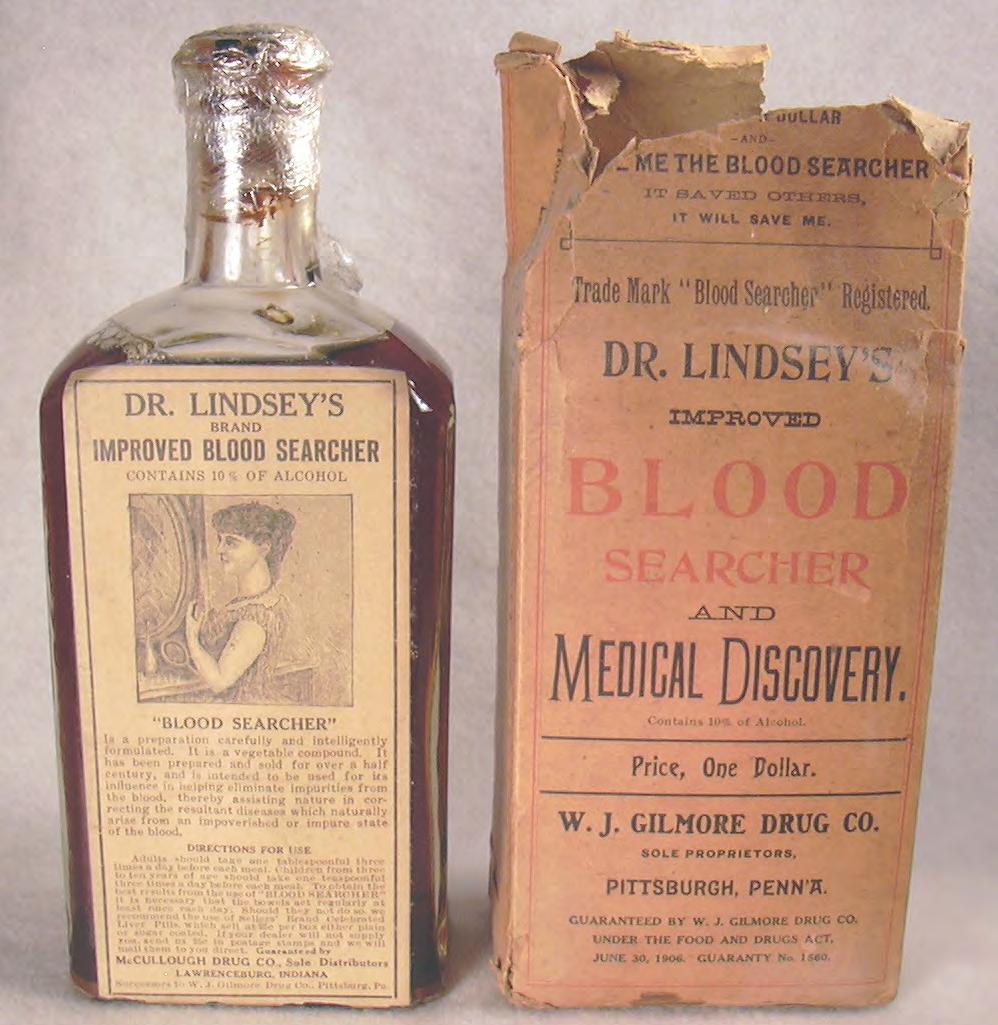
Final Thoughts bottle mold made with the city name of Pittsburgh embossed on Due to this lack of embossing change on the blood searcher made removing Lindsey’s name and replacing it with his own bottles, it is difficult to attribute a specific mold to a specific pro(Keyser molds 1 and 2). After Lindsey returned to manufacturing prietor. Also adding to the confusion is the fact that multiple prohis medicine in 1862, he again would have had a Hollidaysburg prietors were producing the medicine simultaneously and when embossed bottle (mold 1). This would have been the bottle sold the medicine rights changed hands the new proprietors often used in Pittsburgh by Johnston in 1862 and 1863. Whether Fulton had the previous proprietors’ bottles, and bottle molds. However, it their own bottles made when they procured the rights to the blood is almost certain that all Hollidaysburg embossed bottles should searcher from Lindsey in November 1863 is unknown, but they date after 1856 when Lindsey began selling his medicine and bewould have had to have their own bottles made after Lindsey fore 1864 when Lindsey sold his rights to the medicine to Sellers. pulled the rights from them in the fall of 1864 as they continued All Pittsburgh embossed bottles should date after 1861 or 1862 to sell their medicine until the court injunction in July 1867 (mold when the blood searcher rights were sold by Lemon to Keyser. 5 and 6). Sellers used multiple bottle molds over the years (posAny bottle embossed with R.E. Sellers would date after the Sellsibly mold 7 and definitely molds 8 - 10). ers acquisition in fall of 1864. it (mold 2). Then sometime around 1866 Keyser had a new mold My hope for this article is to shed some light on these great To narrow each bottle variant further is based on manufacturing western Pennsylvania medicine bottles. Hopefully, this article techniques and supposition. While it will likely never be valiwill help light the spark of interest in future medicine bottle coldated here is my theory: Lindsey himself and/or Lemon most lectors the same way Jeff’s bottles lit the spark for me. If anyone A SUPER rare Yosemite Beer reverse painted Sign From TheSchwartz Collection likely had an early bottle embossed Hollidaysburg (likely mold 3 has a comment, would like to report an unlisted mold, or would and 4, possibly mold 1). Upon receiving the rights to the medijust like to discuss these bottles feel free to contact me at zackcine from Lemon (in 1861 or 1862), Keyser likely had his own baer5014@gmail.com.
Thursday, July 30 - Sunday, August 2, 2020
Antique Bottle Show & Sales, Bottle Competition, Early Admission, Seminars, Displays, Awards Banquet, Membership Breakfast, Bowling Competition, Silent Auction, Raffle, Children’s Events and more... $5 General Admission Saturday and Sunday half day FOHBC Reno 2020 National Antique Bottle Convention & Expo
See Letter from FOHBC Public Relarions Director this issue.

Go to FOHBC.org for hotel booking information, schedule and dealer contracts. Hotel rooms will go fast!
Richard & Bev Siri (Show Chairs) rtsiri@sbcglobal.net Max Bell (Displays) maxbell1205@gmail.com Warren Friedrich (Show Treasurer) warrenls6@sbcglobal.net
RENO 2022


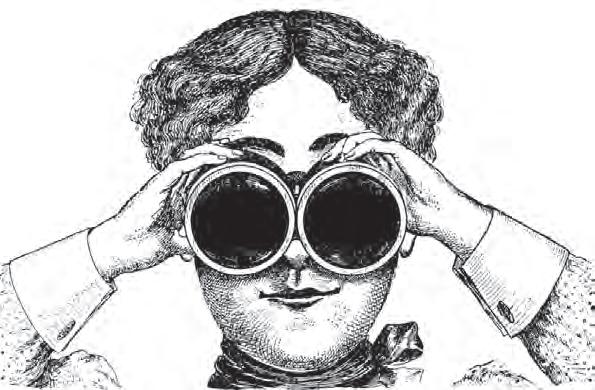
TEAM RENO
Eric McGuire (Seminars, Keynote Speaker) etmcguire@comcast.net Ferdinand Meyer V (Marketing & Advertising) fmeyer@fmgdesign.com Gina Pellegrini (Event Photographer) angelina.pellegrini@gmail.com
NEW DATE: 28 July - 01 August 2022 See fohbc.org for evolving details


Info:








